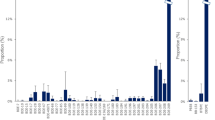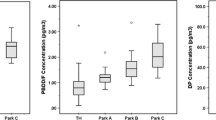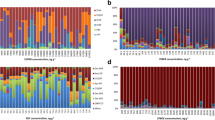Abstract
Settled dust samples from Vietnamese end-of-life vehicle (ELV) processing, urban, and rural areas were analyzed for polybrominated diphenyl ethers (PBDEs) and other current-use brominated flame retardants (BFRs). PBDE levels found in dust samples collected from ELV workshops (median 390; range 120–520 ng/g) and nearby living areas (110; 36–650 ng/g) were generally higher than those in common house dust (25–170 ng/g). BDE-209 was the most predominant congener detected in almost all the samples, indicating extensive application of products containing deca-BDE mixtures. The dust samples from ELV workplaces showed a more abundance of lower brominated congeners (e.g., tetra- to hexa-BDEs) that may originate from car interior materials treated by penta-BDE formulations. Concentrations of other BFRs decreased in the order urban > rural > ELV dust, reflecting the current use of these compounds in new consumer products. Decabromodiphenyl ethane (DBDPE) and 1,2-bis(2,4,6-tribromophenoxy)ethane (BTBPE) were the major alternative BFRs. Daily intake doses and hazard indexes of PBDEs and some other BFRs through dust ingestion were estimated and showed acceptable levels of risk. However, more comprehensive risk assessment considering multiple exposure pathways should be performed, especially for ELV workers and children in the ELV processing and urban areas.


Similar content being viewed by others
Data availability
All data generated or analyzed during this study are included in this published article and its supplementary information files.
References
Al-Omran LS, Harrad S (2016) Polybrominated diphenyl ethers and “novel” brominated flame retardants in floor and elevated surface house dust from Iraq: Implications for human exposure assessment. Emerg Contam 2:7–13
Ali N, Eqani SAMAS, Ismail IMI, Malarvannan G, Kadi MW, Albar HMS, Rehana M, Covaci A (2016) Brominated and organophosphate flame retardants in indoor dust of Jeddah, Kingdom of Saudi Arabia: Implications for human exposure. Sci Total Environ 569–570:269–277
Anh HQ, Nam VD, Tri TM, Ha NM, Ngoc NT, Mai PTN, Anh DH, Minh NH, Tuan NA, Minh TB (2017) Polybrominated diphenyl ethers in plastic products, indoor dust, sediment and fish from informal e-waste recycling sites in Vietnam: a comprehensive assessment of contamination, accumulation pattern, emissions, and human exposure. Environ Geochem Health 39:935–954
Anh HQ, Tomioka K, Tue NM, Tri TM, Minh TB, Takahashi S (2018) PBDEs and novel brominated flame retardants in road dust from northern Vietnam: levels, congener profiles, emission sources and implications for human exposure. Chemosphere 197:389–398
Cahill TM, Groskova D, Charles MJ, Sanborn JR, Denison MS, Baker L (2007) Atmospheric concentrations of polybrominated diphenyl ethers at near-source sites. Environ Sci Technol 41:6370–6377
Cao Z, Zhao L, Kuang J, Chen Q, Zhu G, Zhang K, Wang S, Wu P, Zhang X, Wang X, Harrad S, Sun J (2017) Vehicles as outdoor BFR sources: evidence from an investigation of BFR occurrence in road dust. Chemosphere 179:29–36
Choi J, Jang YC, Kim JG (2017) Substance flow analysis and environmental releases of PBDEs in life cycle of automobiles. Sci Total Environ 574:1085–1094
Coelho SD, Sousa ACA, Isobe T, Kim JW, Kunisue T, Nogueira AJA, Tanabe S (2016) Brominated, chlorinated and phosphate organic contaminants in house dust from Portugal. Sci Total Environ 569–570:442–449
Covaci A, Harrad S, Abdallah MA-E, Ali N, Law RJ, Herzke D, de Wit CA (2011) Novel brominated flame retardants: a review of their analysis, environmental fate and behaviour. Environ Int 37:532–556
Cristale J, Bele TGA, Lacorte S, de Marchi MRR (2018) Occurrence and human exposure to brominated andorganophosphorus flame retardants via indoor dust in a Brazilian city. Environ Pollut 237:695–703
de Wit CA, Kierkegaard A, Ricklund N, Sellstrom U (2010) Emerging brominated flame retardants in the environment. In: Eljarrat E, Barcelo D (eds) The handbook of environmental chemistry Brominated Flame Retardants, vol 16. Springer, Berlin, Heidelberg, pp 241–286
Darnerud PO (2003) Toxic effects of brominated flame retardants in man and in wildlife. Environ Int 29:841–853
Ding N, Wang T, Chen SJ, Yu M, Zhu ZC, Tian M, Luo XJ, Mai BX (2016) Brominated flame retardants (BFRs) in indoor and outdoor air in a community in Guangzhou, a megacity of southern China. Environ Pollut 212:457–463
Drage DS, Sharkey M, Abdallah MAE, Berresheim H, Harrad S (2018) Brominated flame retardants in Irish waste polymers: concentrations, legislative compliance, and treatment options. Sci Total Environ 625:1535–1543
Eguchi A, Isobe T, Ramu K, Tue NM, Sudaryanto A, Devanathan G, Viet PH, Tana RS, Takahashi S, Subramanian A, Tanabe S (2013) Soil contamination by brominated flame retardants in open waste dumping sites in Asian developing countries. Chemosphere 90:2365–2371
Frederiksen M, Vorkamp K, Thomsen M, Knudsen LE (2009) Human internal and external exposure to PBDEs – a review of levels and sources. Int J Hyg Environ Health 212:109–134
Hakk H, Larsen G, Bowers J (2004) Metabolism, tissue disposition, and excretion of 1,2-bis(2,4,6-tribromophenoxy)ethane (BTBPE) in male Sprague-Dawley rats. Chemosphere 54:1367–1374
Hardy M, Biesemeier J, Banasik M, Stedeford T (2008) Comment on “Alternate and new brominated flame retardants detected in U.S. house dust.” Environ Sci Technol 42:9453–9454
He CH, Zheng XB, Yan X, Zheng J, Wang MH, Tan X, Qiao L, Chen SJ, Yang ZY, Mai BX (2017) Organic contaminants and heavy metals in indoor dust from e-waste recycling, rural, and urban areas in South China: spatial characteristics and implications for human exposure. Ecotoxicol Environ Saf 140:109–115
Hearn LK, Hawker DW, Mueller JF (2012) Dispersal patterns of polybrominated diphenyl ethers (PBDEs) in the vicinity of an automotive shredding and metal recycling facility. Atmos Pollut Res 3:317–324
Hearn LK, Hawker DW, Toms LML, Mueller JF (2013) Assessing exposure to polybrominated diphenyl ethers (PBDEs) for workers in the vicinity of a large recycling facility. Ecotoxicol Environ Saf 92:222–228
Hoang AQ, Tran TM, Tu MB, Takahashi S (2021a) Polybrominated diphenyl ethers in indoor and outdoor dust from Southeast Asia: an updated review on contamination status, human exposure, and future perspectives. Environ Pollut 272:116012
Hoang MTT, Anh HQ, Kadokami K, Duong HT, Hoang HM, Nguyen TV, Takahashi S, Le GT, Trinh HT (2021b) Contamination status, emission sources, and human health risk of brominated flame retardants in urban indoor dust from Hanoi, Vietnam: the replacement of legacy polybrominated diphenyl ether mixtures by alternative formulations. Environ Sci Pollut Res 28:43885–43896
Hoh E, Zhu L, Hites RA (2005) Novel flame retardants, 1,2-bis(2,4,6-tribromophenoxy)ethane and 2,3,4,5,6-pentabromoethylbenzene, in United States’ environmental samples. Environ Sci Technol 39:2472–2477
Johnson-Restrepo B, Kannan K (2009) An assessment of sources and pathways of human exposure to polybrominated diphenyl ethers in the United States. Chemosphere 76:542–548
Jones-Otazo HA, Clarke JP, Diamond ML, Archbold JA, Ferguson G, Harner T, Richardson GM, Ryan JJ, Wilford B (2005) Is house dust the missing exposure pathway for PBDEs? An analysis of the urban fate and human exposure to PBDEs. Environ Sci Technol 39:5121–5230
Kalachova K, Hradkova P, Lankova D, Hajslova J, Pulkrabova J (2012) Occurrence of brominated flame retardants in household and car dust from the Czech Republic. Sci Total Environ 441:182–193
Khan MU, Li J, Zhang G, Malik RN (2016) New insight into the levels, distribution and health risk diagnosis of indoor and outdoor dust-bound FRs in colder, rural and industrial zones of Pakistan. Environ Pollut 216:662–674
Kierkegaard A, Bjorklund J, Friden U (2004) Identification of the flame retardant decabromodiphenyl ethane in the environment. Environ Sci Technol 38:3247–3253
Kuang J, Ma Y, Harrad S (2016) Concentrations of “legacy” and novel brominated flame retardants in matched samples of UK kitchen and living room/bedroom dust. Chemosphere 149:224–230
Kurt-Karakus, PB, Alegria H, Jantunen L, Birgul A, Topcu A, Jones KC, Turgut C (2017) Polybrominated diphenyl ethers (PBDEs) and alternative flame retardants (NFRs) in indoor and outdoor air and indoor dust from Istanbul-Turkey: Levels and an assessment of human exposure. Atmos Pollut Res 8:801–815
La Guardia MJ, Hale RC, Harvey E (2006) Detailed polybrominated diphenyl ether (PBDE) congener composition of the widely used penta-, octa-, and deca-PBDE technical flame-retardant mixtures. Environ Sci Technol 40:6247–6254
Lagalante AF, Shedden CS, Greenbacker PW (2011) Levels of polybrominated diphenyl ethers (PBDEs) in dust from personal automobiles in conjunction with studies on the photochemical degradation of decabromodiphenyl ether (BDE-209). Environ Int 37:899–906
Lam JCW, Lam PKS (2015) Occurrence and ecological risk of halogenated flame retardants (HFRs) in coastal zones. In: Zheng EY (ed) Comprehensive analytical chemistry persistent organic pollutants (POPs): analytical techniques, environmental fate and biological effects, Elsevier 67:389–410
Lee SC, Sverko E, Harner T, Pozo K, Barresi E, Schachtschneider J, Zaruk D, DeJong M, Narayan J (2016) Retrospective analysis of “new” flame retardants in the global atmosphere under the GAPS Network. Environ Pollut 217:62–69
Li J, Chen Y, Xiao W (2017) Polybrominated diphenyl ethers in articles: a review of its applications and legistration. Environ Sci Pollut Res 24:4312–4321
McGrath TJ, Morrison PD, Ball AS, Clarke BO (2017) Detection of novel brominated flame retardants (NBFRs) in the urban soils of Melbourne, Australia. Emerg Contam 3:23–31
McGrath TJ, Morrison PD, Ball AS, Clarke BO (2018) Concentrations of legacy and novel brominated flame retardants in indoor dust in Melbourne, Australia: an assessment of human exposure. Environ Int 113:191–201
Muenhor D, Harrad S, Ali N, Covaci A (2010) Brominated flame retardants (BFRs) in air and dust from electronic waste storage facilities in Thailand. Environ Int 36:690–698
Ni HG, Lu SY, Mo T, Zeng H (2016) Brominated flame retardant emissions from the open burning of five plastic wastes and implications for environmental exposure in China. Environ Pollut 214:70–76
Nomeir AA, Markham PM, Ghanayem BI, Chadwick M (1993) Disposition of the flameretardant 1,2-bis(2,4,6-tribromophenoxy)ethane in rats following administration in the diet. Drug Metab Dispos 21:209–214
Osada M, Tanigaki N, Takahashi S, Sakai S (2008) Brominated flame retardants and heavy metals in automobile shredder residue (ASR) and their behavior in the melting process. J Mater Cycles Waste Manag 10:93–101
Peng C, Tan H, Guo Y, Wu Y, Chen D (2017) Emerging and legacy flame retardants in indoor dust from East China. Chemosphere 186:635–643
Qi H, Li WL, Liu LY, Zhang ZF, Zhu NZ, Song WW, Ma WL, Li YF (2014) Levels, distribution and human exposure of new non-BDE brominated flame retardants in the indoor dust of China. Environ Pollut 195:1–8
Redin L, Niinipuu M, Jansson S (2017) Occurrence of brominated diphenyl ethers, dibenzo-p-dioxins and dibenzofurans in foam materials in scrapped car seats from 1985 to 2012. Waste Manag 61:300–306
Sakai S, Yoshida H, Hiratsuka J, Vandecasteele C, Kohlmeyer R, Rotter VS, Passarini F, Santini A, Peeler M, Li J, Oh GJ, Chi NK, Bastian L, Moore S, Kajiwara N, Takigami H, Itai T, Takahashi S, Tanabe S, Tomoda K, Hirakawa T, Hirai Y, Asari M, Yano J (2014) An international comparative study of end-of-life vehicle (ELV) recycling systems. J Mater Cycles Waste Manag 16:1–20
Shi T, Chen SJ, Luo XJ, Zhang XL, Tang CM, Luo Y, Ma YJ, Wu JP, Peng XZ, Mai BX (2009) Occurrence of brominated flame retardants other than polybrominated diphenyl ethers in environmental and biota samples from southern China. Chemosphere 74:910–916
Sjodin A, Carlsson H, Thuresson K, Sjolin S, Bergman A, Ostman C (2001) Flame retardants in indoor air at an electronics recycling plant and at other work environments. Environ Sci Technol 35:448–454
Stapleton HM, Dodder NG (2008) Photodegradation of decabromodiphenyl ether in house dust by natural sunlight. Environ Toxicol Chem 27:306–312
Takahashi S, Tue NM, Takayanagi C, Tuyen LH, Suzuki G, Matsukami H, Viet PH, Kunisue T, Tanabe S (2017) PCBs, PBDEs and dioxin-related compounds in floor dust from an informal end-of-life vehicle recycling site in northern Vietnam: Contamination levels and implications for human exposure. J Mater Cycles Waste Manag 19:1333–1341
Tran LT, Kieu TC, Bui HM, Nguyen NT, Nguyen TTT, Nguyen DT, Nguyen TQ, Nguyen HTA, Le TH, Takahashi S, Tu MB, Hoang AQ (2022) Polybrominated diphenyl ethers in indoor dusts from industrial factories, offices, and houses in northern Vietnam: contamination characteristics and human exposure. Environ Geochem Health 44:2375–2388
Tue NM, Takahashi S, Suzuki G, Isobe T, Viet PH, Kobara Y, Seike N, Zhang G, Sudaryanto A, Tanabe S (2013) Contamination of indoor dust and air by polychlorinated biphenyls and brominated flame retardants and relevance of non-dietary exposure in Vietnamese informal e-waste recycling sites. Environ Int 51:160–167
UNEP (2015) UNEP/POPS/POPRC.11/10/Add.1. Risk management evaluation on decabromodiphenyl ether (commercial mixture, c-decaBDE). http://chm.pops.int/Implementation/Alternatives/AlternativestoPOPs/ChemicalslistedinAnnexA/cdecaBDE/tabid/5985/Default.aspx (accessed 9 April 2018)
UNEP (2017) Guidance for the inventory of polybrominated diphenyl ethers (PBDEs) listed under the Stockholm Convention on Persistent Organic Pollutants. http://chm.pops.int/Implementation/NIPs/Guidance/GuidancefortheinventoryofPBDEs/tabid/3171/Default.aspx (accessed 29 March 2018)
US EPA (1987) Intergrated Risk Information System 1987. https://cfpub.epa.gov/ncea/iris (accessed 17 March 2018)
US EPA (2008) Intergrated Risk Information System 2008. https://cfpub.epa.gov/ncea/iris (accessed 17 March 2018)
Venier M, Audy O, Vojta S, Bečanová J, Romanak K, Melymuk L, Krátkáb M, Kukučka P, Okeme J, Saini A, Diamond ML, Klánová J (2016) Brominated flame retardants in the indoor environment–comparative study of indoor contamination from three countries. Environ Int 94:150–160
Wang J, Ma YJ, Chen SJ, Tian M, Luo XJ, Mai BX (2010) Brominated flame retardants in house dust from e-waste recycling and urban areas in South China: implications on human exposure. Environ Int 36:535–541
Wang J, Wang Y, Shi Z, Zhou X, Sun Z (2018) Legacy and novel brominated flame retardants in indoor dust from Beijing, China: occurrence, human exposure assessment and evidence for PBDEs replacement. Sci Total Environ 618:48–59
Watanabe I, Sakai S (2003) Environmental release and behavior of brominated flame retardants. Environ Int 29:665–682
Xu F, Liu YC, Wang J, Zhang G, Zhang W, Liu L, Wang J, Pan B, Lin K (2015) Characterization of heavy metals and brominated flame retardants in the indoor and outdoor dust of e-waste workshops: implication for on-site human exposure. Environ Sci Pollut Res 22:5469–5480
Yadav IC, Devi NL, Li J, Zhang G (2017) Occurrence and source apportionment of halogenated flame retardants in the indoor air of Nepalese cities: implication on human health. Atmos Environ 161:122–131
Yadav IC, Devi NL, Li J, Zhang G (2018) Environmental concentration and atmospheric deposition of halogenated flame retardants in soil from Nepal: source apportionment and soil-air partitioning. Environ Pollut 233:642–654
Zheng X, Xu F, Chen K, Zeng Y, Luo X, Chen S, Mai B, Covaci A (2015) Flame retardants and organochlorines in indoor dust from several e-waste recycling sites in South China: composition variations and implications for human exposure. Environ Int 78:1–7
Acknowledgement
Fund for the Promotion of Joint International Research (Fostering Joint International Research (B)) (18KK0300) was from the Japan Society for the Promotion of Science (JSPS).
Funding
Anh Quoc Hoang, ID VNU.2021.TTS.01, thanks the Development Foundation of Vietnam National University, Hanoi, for sponsoring this research.
Author information
Authors and Affiliations
Contributions
Anh Quoc Hoang, Shin Takahashi, Nguyen Minh Tue, Le Huu Tuyen, Tri Manh Tran, Nguyen Thi Hong Yen, and Minh Binh Tu contributed to the study conception and design, material preparation, data collection, and analysis. The first draft of the manuscript was written by Anh Quoc Hoang, and all authors commented on previous versions of the manuscript. All authors read and approved the final manuscript.
Corresponding author
Ethics declarations
Ethics approval
Not applicable.
Research involving human participants, animals, their data, or biological material
Not applicable.
Consent to participate
Not applicable.
Consent for publication
Not applicable.
Competing interests
The authors declare no competing interests.
Additional information
Responsible Editor: Constantini Samara
Publisher's note
Springer Nature remains neutral with regard to jurisdictional claims in published maps and institutional affiliations.
Supplementary Information
Below is the link to the electronic supplementary material.
Rights and permissions
Springer Nature or its licensor holds exclusive rights to this article under a publishing agreement with the author(s) or other rightsholder(s); author self-archiving of the accepted manuscript version of this article is solely governed by the terms of such publishing agreement and applicable law.
About this article
Cite this article
Hoang, A.Q., Takahashi, S., Tue, N.M. et al. Occurrence, emission sources, and risk assessment of polybrominated diphenyl ethers and current-use brominated flame retardants in settled dust from end-of-life vehicle processing, urban, and rural areas, northern Vietnam. Environ Sci Pollut Res 30, 2061–2074 (2023). https://doi.org/10.1007/s11356-022-22396-z
Received:
Accepted:
Published:
Issue Date:
DOI: https://doi.org/10.1007/s11356-022-22396-z




